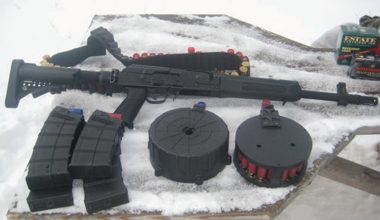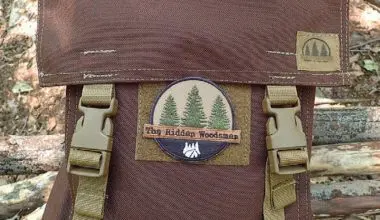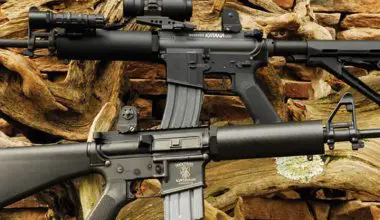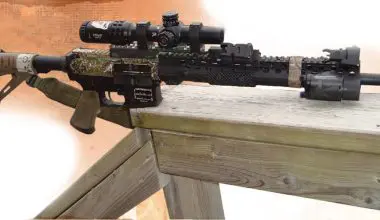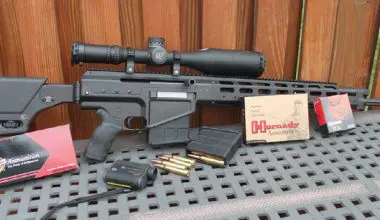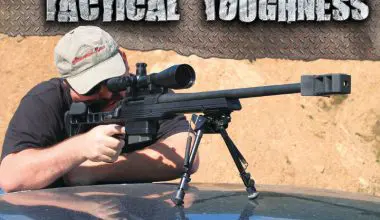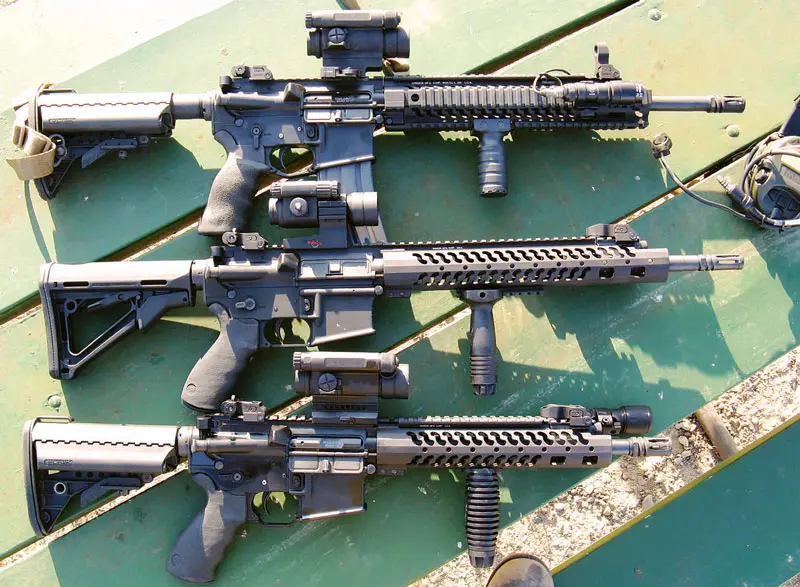
IN the Midwest United States, Mills Fleet Farm is a chain of stores that many consider the place where men go to shop. You can grab what you need for your cows at one end of the store, pick up another pair of work gloves and blue jeans in the middle, and finish the trip by buying a new fishing lure and a brick of .22 Long Rifle.
The Mills Fleet Farm logo and its employee uniforms stand out as symbols of rural life. In the past, it was a place that advertised Marlin and Winchester .30-30s, Remington and Mossberg 12-gauge shotguns, and Ruger and Marlin .22 rifles. It sold pretty much the same sporting guns that every other hardware and box store sold. No handguns, no ordering the latest black rifle, no firearms that didn’t fit the mold of what some consider sporting arms.
By now some of you are asking what this has to do with the mission of S.W.A.T. Magazine.
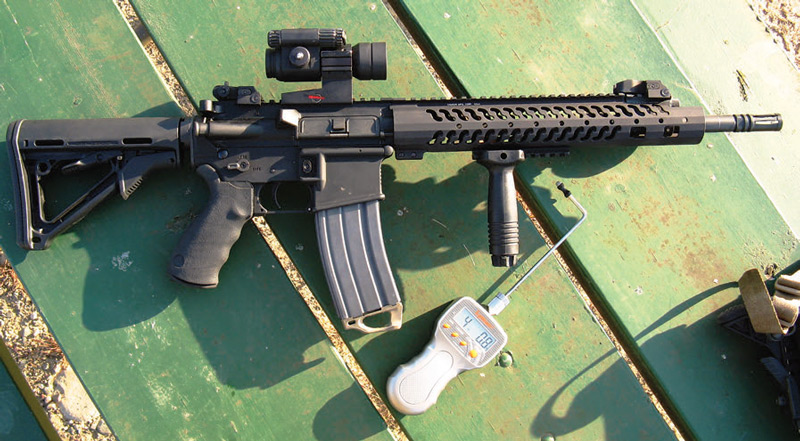
Table of Contents
CHANGING TIMES AT MILLS FLEET FARM
Stewart Mills III, Vice President of Mills Fleet Farm and one of the younger generation of Fleet Farm’s management, has begun changing some of what Fleet Farm carries. While they have been one of the top sales locations for hunting and fishing licenses, these sales have been steadily declining.
But shooting sports gear sales have continued to increase. Stewart saw that he couldn’t buy the firearms at Fleet Farms he and many other shooters were using, and thus FF was losing a market share. Stewart said it was a hard fight getting past the traditional values of the Fleet Farm higher-ups. He would show them an AR-15 and they would ask, “What can you hunt with it?” The fact that shooting sports involved more than hunting was a foreign concept.
Stewart finally won some support to open up the stores to new products based on shooting versus hunting, with obvious success. The story continues when Stewart talked to a local peace officer. That agency traded their UMP subguns for AR-pattern carbines. They unfortunately bought them from a manufacturer that is popular with cops based on price, not quality. The officer relayed the vast number of problems they were experiencing, including gas blocks fracturing.
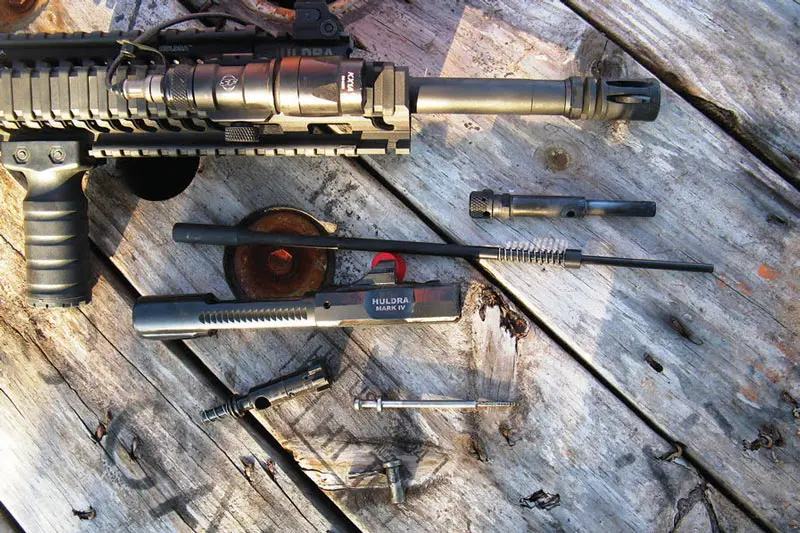
DI GAS SYSTEM
Stewart felt there had to be a better way and thought the direct impingement (DI) gas system was a major cause of the lack of reliability.
The DI versus piston debate is akin to the PC/Mac and Ford/Chevy rivalries. Everyone has an opinion. It is irrefutable that DI guns exist that have been demonstrated to flat out work when built with good quality control and the addition of lube at manageable intervals.
Some shooters need the advantages a piston system offers, and others don’t care to have the gases, lube, and sludge that forms clinging to the inside of the upper receiver and bolt carrier.
Stewart followed his own preferences and sought to find a Fleet Farm solution to the DI system issues he saw. He got a hold of various piston gun offerings and looked at them to find out what made them tick. He bought LWRC, Stag, and SIG long-piston guns, and an HK. Each of them had their advantages and disadvantages, but still were not quite what he was looking for. Some required tools for disassembly, some had gas regulation issues, and they were not as simple as he wanted a product to be.
Enter Jim Granger, Vice President of Adams Arms. Stewart received one of their piston kits and found the reliability and simplicity he wanted. He spoke to Jim about building a complete piston rifle for Fleet Farm, and the two of them walked from booth to booth at a SHOT Show shopping various components for the finished product. Huldra Arms was born.
HULDRA ARMS
Huldra Arms rifles are still relatively new to the scene. I myself had heard the name, but had been extensively using another brand of carbine that has worked quite well for me. I didn’t really pay attention to yet another AR system weapon.
I was approached by Mike Davis, a law enforcement officer and part of Timm Training. Mike has been helping Huldra with hands-on testing of their guns, as well as hosting training classes for the central Minnesota region.
Mike asked if I would be willing to write a couple of unbiased articles on a training class while using a Huldra carbine. I agreed and arrived at a Trident Concepts Combative Carbine Two course with Jeff Gonzales, wondering if I would see what all the fuss was about a piston gun.
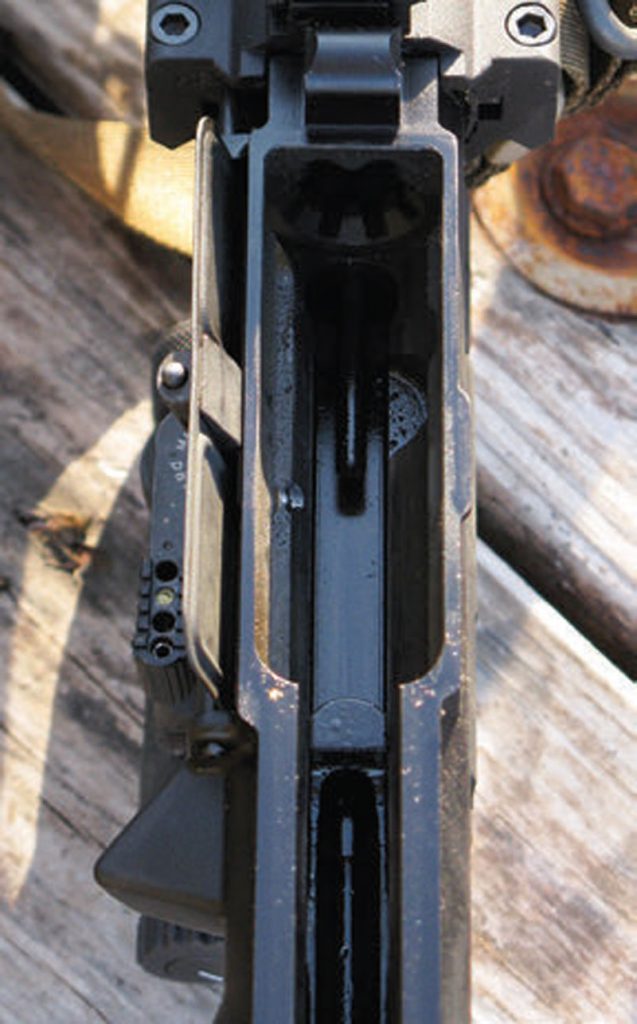
The night before the class, Mike handed me a rifle case and 2,000 rounds of Federal XM193. Inside the case was a Huldra Mark IV Tactical Elite with Aimpoint M4 RDS on a LaRue mount. Some additional accessories needed for the class were inside, and I was encouraged to set everything up on the carbine as I needed.
HULDRA TAC ELITE
At first glance, the Huldra Tac Elite looks like most other railed AR carbines on the market. The main obvious difference is the solid gas block for the short piston system, with an adjustable gas system on the front. The piston block is straight pinned for ease of manufacturing and also uses a set screw for redundancy.
David Timm, Training Coordinator and Technical Support for Huldra Arms, told me the gas plug is at normal operation when at the 12 o’clock position, and is turned to the 9 o’clock for removal. If one is using a suppressor and needs to reduce gas, the gas plug is turned to 1 o’clock. The 3 o’clock position turns the carbine into a single shot, and the piston will not cycle. Timm says that law enforcement agencies also have the option of having a gas system that only allows for normal operation and disassembly.
The actual piston system is fairly simple and involves a minimum of proprietary parts. Huldra carbines use the same bolt, cam pin and firing pin as their DI AR platform cousins, but use a one-piece carrier that eliminates the gas keys found on DI carriers.
Removal of the gas plug allows the user to withdraw the drive rod. It is quick, easy and doesn’t involve keeping track of parts you set down for maintenance.
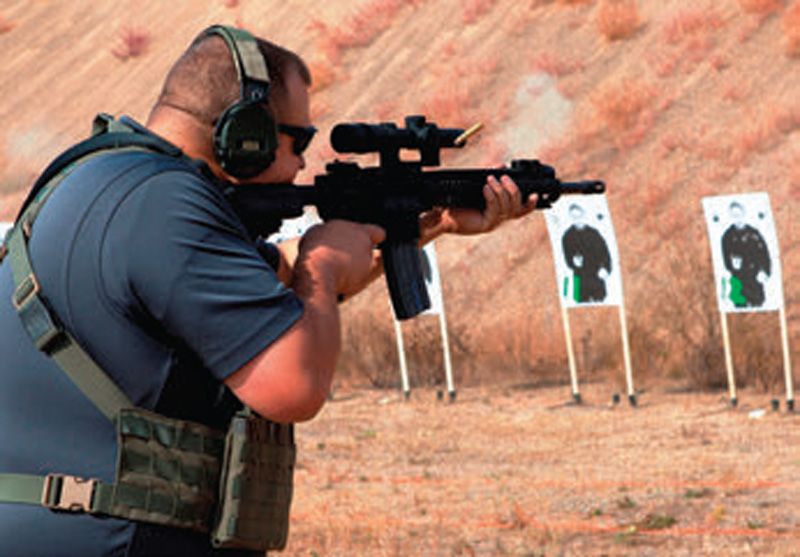
Another important part of the carbine is the barrel. Huldra carbines are specified with 4150 CMV steel with Melonite coatings instead of chrome lining. It is a high quality barrel comparable to other quality manufacturers.
While some will say that’s not milspec, Stewart believes there are still ways the AR platform can be improved beyond the minimum milspec standard, and the use of Melonite to increase velocity and accuracy is one such improvement.
FEATURES AND ACCESSORIES
The rail offered by Huldra is a Samson two-piece monolithic. Stewart and Timm stated there are currently 31 different aftermarket rails and forends that will fit on Huldra piston guns, including Magpul, Daniel Defense, Samson, and others. A SureFire Scout light with tape switch, Magpul ladder covers, and Blackhawk Vertical Grip complete the forend.
Huldra carbines currently come with Samson folding front and rear back-up sights. Back-up sights are selected largely by user preference, and while these work well for the range, I don’t like them for law enforcement use. The rear windage is too easily moved and I don’t like having to push a button to unlock the sight to raise it.
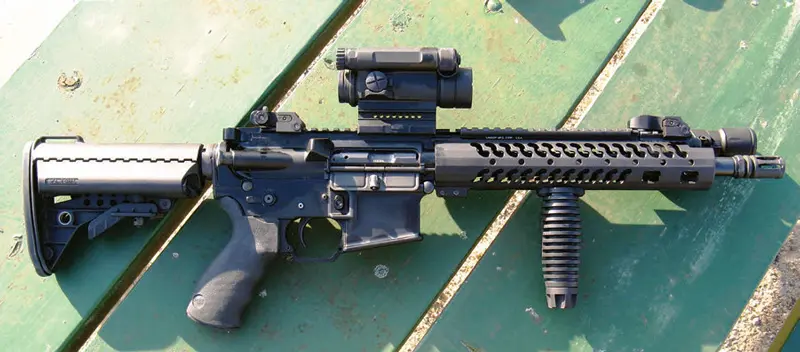
Another point to be aware of is that the Samson rear apertures are not same plane and may cause issues with various zeros and points of impact. Huldra is now addressing this to better meet the needs of their customers.
Stewart made sure the rear receiver extension was milspec diameter versus commercial, and he currently offers Magpul and VLTOR collapsible stocks on the Huldra models.
Grips are also a matter of user preference. Ergo and Magpul grips were selected to be part of the Huldra packages mainly due to their popularity with those buying Huldras and using them in 3-gun competitions. My Tac Elite had an Ergo installed and felt just like my issued MP5 did years ago. The grip worked fine, but I prefer a different grip angle when supporting the carbine’s weight onehanded, and would probably choose the Magpul for personal use.
The front of the magwell has a chevron design on it. At first glance, I was dismayed, thinking Huldra Arms had fallen victim to some expert who promoted the antiquated front magwell grip.
I asked Stewart about this, and he explained that at the Ozark 3-Gun Championship, he’d seen a U.S. Army Squad Designated Marksman use the front magwell and his palm to cinch his body tighter to achieve tighter groups. Stewart made the chevrons a feature on the Huldra to benefit those who wanted something other than a smooth front.
The trigger installed in my lower was a JP Enterprises EZ Trigger™ that averaged four pounds on a trigger pull gauge. The trigger was crisp and excellent for concentrating on my sights and prone shooting technique. Many people comment on the feel of the Huldra’s trigger.
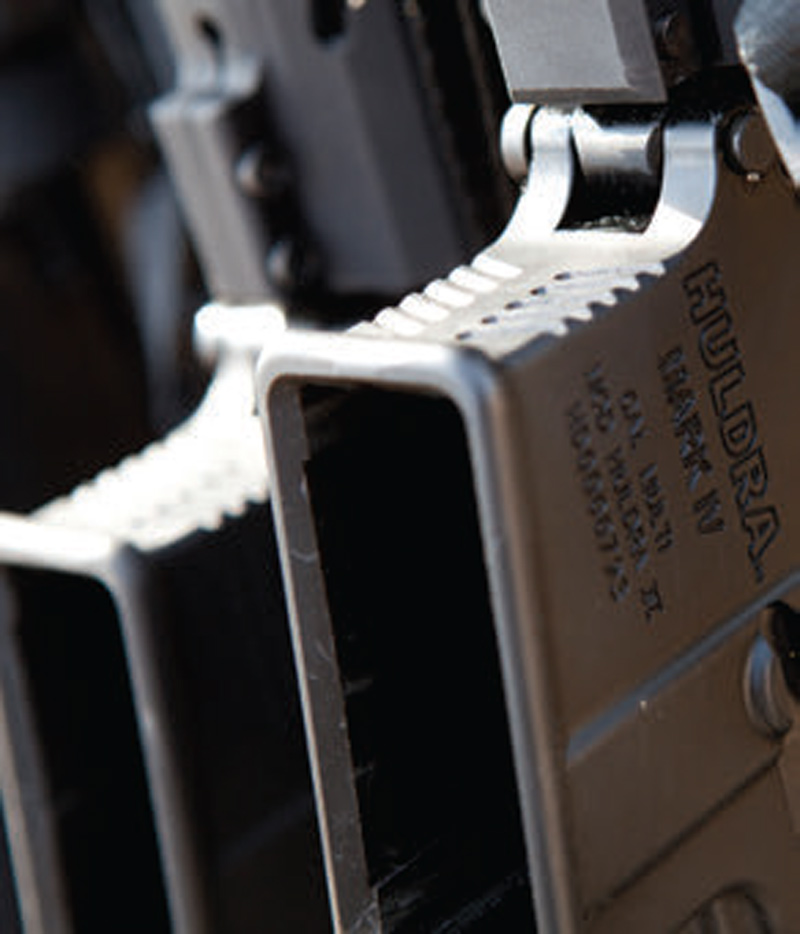
To me, the trigger is a welcome improvement over milspec triggers for helping achieve tight groups in competition or hunting, but as I went through the class, I felt it is not a trigger I would want on a fighting gun. I’m not a fan of internal parts that allow adjustments that will be subject to the constant vibrations of a patrol vehicle environment.
There is the thread locker solution, but my experience has been that it won’t even enter the minds of many actually in charge of cop guns. The good news is that Huldra carbines are available with standard milspec type fire control groups for this exact reason if specified.
TRIDENT CONCEPTS COMBATIVE CARBINE TWO
I fired nearly 1,600 rounds over three days through the Mark IV Tactical Elite. Jeff Gonzales runs very fast-paced courses, and you give your weapons a workout—they get hot and they stay hot.
The range I was on was tucked back in a large quarry, where blowing sand and grit were not uncommon. This particular range and its conditions were some of the most severe I have ever run a carbine in. I lubed the Tac Elite with Slip 2000 at the beginning of TD1 and TD3, although it didn’t seem to need it yet on TD3. It balanced well, and I had no problems with accuracy, nor any malfunctions that weren’t set up as part of the course.
Jeff Gonzales has high accuracy standards for his courses, and I was one of the few to pass it. I was able to maintain one- to two-inch groups at 50 yards using an Aimpoint and shooting ammunition that commonly has a quality control expectation of four MOA. I mention this not to talk myself up, but to illustrate that if the shooter can do their job, the Huldra carbines will perform.
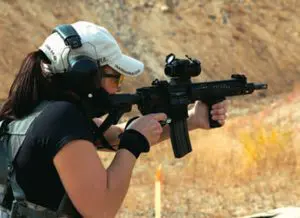
1,600 ROUNDS LATER …
When the course was over, I separated the upper and lower to examine them. While there was some residue inside the lower and on the carrier, it was not what I expected to see after the high round count. What I saw was something that would require only a few minutes maintenance to wipe off, and I could see why the relatively clean internals appeal to some shooters.
There was also absolutely no wear at the rear of the lower receiver or the front of the receiver extension from the carrier tilt problem that occurs in some other piston systems.
OTHER MODELS
Huldra offers a basic carbine model that uses carbine-length handguards instead of rails, as well as a 14.5-inch barreled model using the slim Samson Evo rail. They offer uppers to use a piston system on your existing lower, and a 5.45mm caliber carbine and upper for those who wish to use lower cost surplus ammunition.
The models are priced comparably to similar quality DI carbines, and more shooters are getting exposed to the value and advantages of ARs than ever before. The more I shot the Tactical Elite, the more I appreciated it. It was hard to hand back the rifle when we were finished.
I developed a respect for the system, enough that if I were issued one I would have no qualms about carrying it to protect myself or others.
